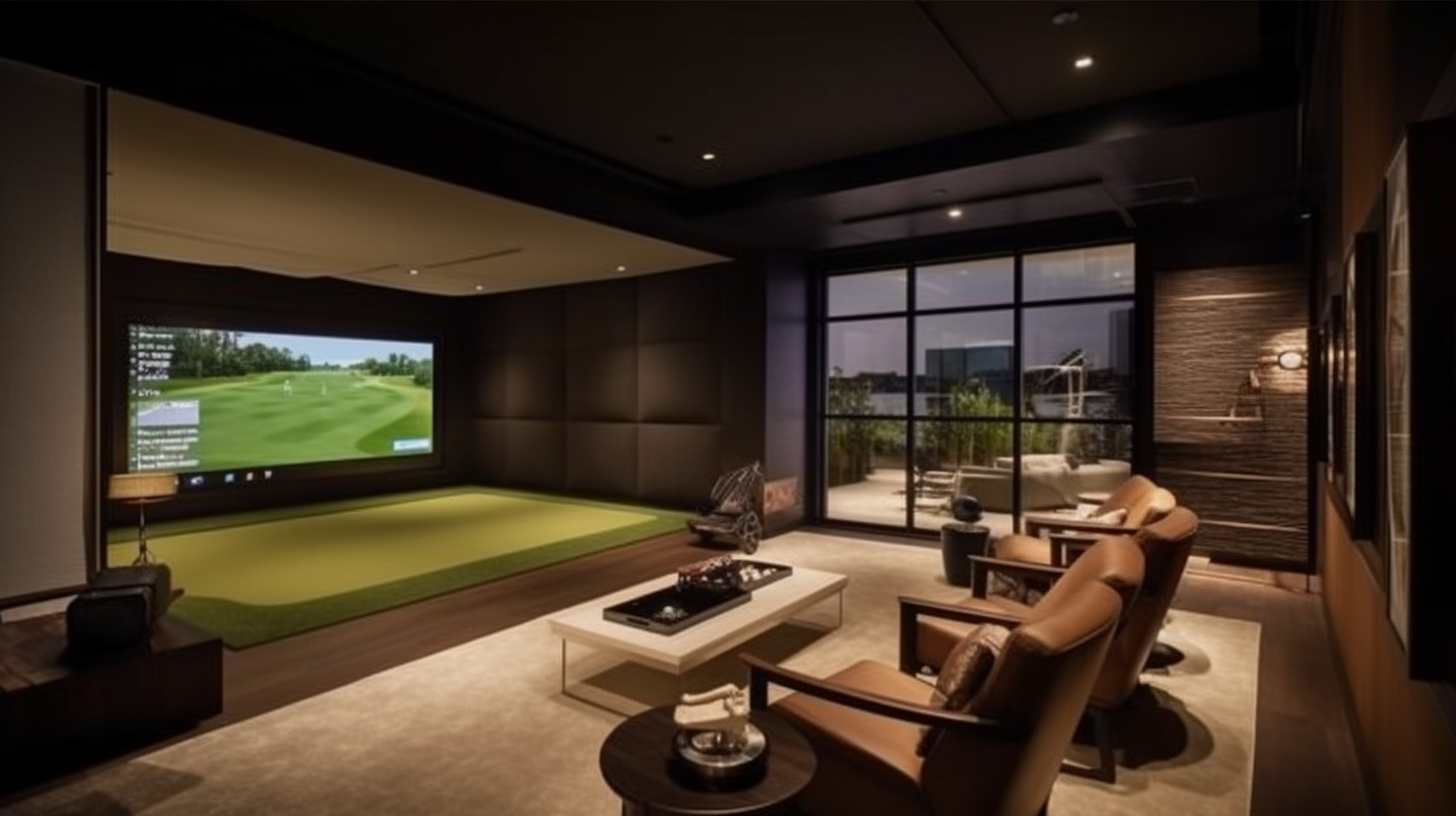Have you ever wondered what it would cost to bring the golf course right into your own home or facility for play any time, in any weather?
Installing a versatile, realistic golf simulator runs $3,000 to over $60,000 depending on the technology sophistication preferences, accessories included, available space and professional installation options selected.
Let’s dive into the pricing considerations and typical ranges for building basic single bay enclosures to elaborate multi-player golf entertainment complexes.
How Much Is a Golf Simulator

The total cost of a basic, functional golf simulator starts around $3,000. This covers an enclosed hitting bay, impact screen, basic swing sensors, mat, and software with a few courses.
As more advanced technology, larger spaces, accessories and professional installations are incorporated, the price can surpass $60,000. Realistic and versatile home simulators typically cost between $8,000 to $15,000 depending on included features.
Commercial entertainment venues invest upwards of $25,000 for their multi-bay configurations and elite technology capabilities.
So while a very basic golf simulator enclosure can be constructed for a few thousand dollars, prices extend all the way into the tens of thousands for premium experiences.
What Is A Golf Simulator

A golf simulator is an indoor interactive sports system that allows golfers to simulate playing on actual golf courses. The simulator uses advanced technology to track detailed motion data of players’ swings and ball flight to render a virtual recreation of golf shots.
Golf simulators feature high-tech launch monitors, impact sensors, enclosed hitting bays, screens, and simulator software to provide a realistic golfing experience indoors.
Golfers can practice driving, approach shots, chipping, and putting while receiving instant feedback and analytics without needing access to an outdoor driving range or golf course.
Golf simulators bring convenience, entertainment, skill analysis, and improvement possibilities that are not possible outdoors. They can be installed permanently in homes, commercial venues, teaching academies, etc.
Portable enclosure golf simulators are also available. Prices range from a few thousand dollars for basic enclosures and swing analysis to over $60,000 for elaborate multi-bay golf entertainment centers.
Golf Simulator Cost Considerations

Purchasing and installing a golf simulator is a significant investment that can pay dividends for years to come through convenience, entertainment, improved skills and more.
But accurately budgeting the expenses requires understanding several cost factors involved with constructing an engaging, functional simulated golf environment indoors.
From the space needed, to the base technology package selection, installation methods and ongoing ownership commitments, there are myriad considerations influencing overall pricing across all budget ranges.
Carefully weighing each element will equip buyers to make informed simulator purchases that meet their needs and avoid surprises down the road.
Space Needed
The amount of space available is a key cost factor when installing a golf simulator. Indoor home simulators usually require a dedicated room or garage bay with dimensions of at least 12 feet wide by 20 feet deep and 10 feet high ceiling height.
Commercial golf simulators at entertainment venues, teaching academies, etc. may feature larger hitting bay enclosures to accommodate more players and activities. Portable golf simulators provide more flexibility if space is limited.
They can be set up and taken down as needed in vacant rooms, rented spaces, etc. But portables generally offer fewer features than permanent builds. The needed dimensions also depend on the type of simulator technology selected.
More advanced systems with added features for putting, chipping, teaching, video analysis, entertainment options, etc. require considerably more space than basic single bay driving enclosures.
Technology Package
The simulator technology tier selected drives the overall cost more than any other factor. Basic models start under $5,000 and feature realistic virtual golf course graphics and data analysis of swing path, club head speed, ball speed, launch angle and other shot metrics.
Mid-range systems add details like sidespin, height, body positioning etc. High-end models over $25,000 incorporate comprehensive club and ball tracking to perfectly replicate every shot shape, curve, divot and result for an ultra-realistic experience.
The computer processing power, quality of impact sensors, swing cameras and software realism improve substantially on more advanced systems.
Golf simulators also require strong broadband internet connections and high-definition projectors or monitors to display the virtual courses. Some packages include these items while others allow golfers to incorporate their own screens and computers to save costs.
Additional accessories like putting greens, swing aids, entertainment options etc. can be added onto any system.
Installation
Golfers have the option on many systems to do their own building and installation work for the enclosure, electrical, lighting, screens and other elements of the simulator package.
But for most homeowners it makes sense to hire contractors handle the specialized construction, wiring and calibration involved, which starts around $5,000.
The easiest option is having an all-in-one pre-configured simulator system delivered and installed by the company professionally.
Course software packages cost a few hundred to a few thousand dollars depending on the quality of graphics, variety of courses and customization abilities. Simple single course options work well for most casual users.
But teaching academies, commercial entertainment venues and some avid enthusiasts opt for membership packages granting access to hundreds of simulated courses around the world, tournaments, and other add-ons.
Ongoing Operating Costs
While the upfront building and acquisition costs are the largest portion, operating and occasionally upgrading simulator technology is recommended to keep the experience realistic.
Hitting mats designed for thousands of swings eventually wear down and need replacement every 3-5 years. Software enhancement packages improve graphics, swing analysis and recreate new courses.
Support contracts provide technical assistance and repairs from the vendor if anything malfunctions. For commercial entertainment type simulators, replacements and upgrades run $5,000 to $10,000 every few years.
Home systems see less use so smaller upgrades around $1,000 every 5 years is typical. Some vendors also offer memberships granting access to new software courses, tournaments and features as they are released for a monthly or annual fee.
Golf Simulator Price Ranges

There is incredible variation in golf simulator pricing based on the technology sophistication, build quality, included accessories and installation options selected.
Entry-Level Golf Simulators
Basic single bay golf simulator enclosures start around $3,000-$7,000. They include an impact screen, basic swing/ball flight sensors, a hitting mat, computer software to display shot results and some course options.
Graphics and analytics are realistic but lack extensive shot shaping possibilities beyond straight drives. Enclosures are usually made from netting or impact-resistant materials.
DIY installation is common for entry-level systems but professional help is recommended unless the golfer is highly experienced with construction and wiring projects.
These basic simulators allow working on the mechanics of a straight golf swing and getting accurate feedback on shot distance, height and other metrics. But the course variety and shot versatility is limited.
Additional courses usually cost a few hundred dollars each.
Mid-Range Golf Simulators
Mid-range systems run from $8,000 to $15,000. They include more advanced swing analysis cameras, sensors and software for modeling curved shots, wind impacts, rough lies and hazard situations for a very realistic experience.
Digital displays show video replays from multiple camera angles alongside data analytics to identify ways to improve upon each swing.
The simulator enclosures at this price range often feature actual synthetic turf hitting surfaces, higher weight limits and room for additional players. Mid-range systems model shots with enough accuracy to require strategic course management skills just like an outdoor round.
Course libraries typically start around 25 Championship courses with expansion packages available. Integrating some accessories like putting greens is popular with mid-range simulator setups.
Professional installation is highly recommended due to the wiring and calibration needs.
High-End Golf Simulators
The top tier of golf simulators stretches from around $16,000 into the $60,000+ range. They incorporate advanced robotics, multi-camera tracking solutions and sensors to perfectly measure every minute detail of clubs and balls during shots for ultra-realistic play.
Ball spin, launch angles, curve/shape and speed are modeled precisely to match real on-course performance. High-end systems allow for full short game play including chips, pitches, bunker shots and putting.
Enclosure designs emphasize spacious hitting areas with flooring, lighting and decor emulating luxury course aesthetics. Some high-end models feature interchangeable hitting bay surfaces to replicate fairway, rough, sand and other lies.
They have large libraries of courses available and allow groups to simulate playing together in different locations while displaying scores, earnings and statistics to create tournaments, betting games and entertainment.
These elite golf simulators provide teaching professionals all the information needed for in-depth lessons and club fitting sessions.
While costing over 4 times more than basic models, high-end simulators deliver an experience indistinguishable from being on an actual golf course.
Ways To Save On Golf Simulator Costs

While flagships with all the latest features run upwards of $60,000, there are ways to enjoy an indoor golf simulator without spending a fortune.
Buy Used Golf Simulator Equipment
The golf simulation industry sees new technology introductions each year. So 1-3 year old model enclosures, sensors, computing hardware and even software can be purchased second-hand for 30-50% discounts off retail pricing.
Private sellers and specialty resale sites offer refurbished equipment in great condition. This is an excellent way for home users to access better components that were originally out of their budget.
Just be sure to test functionality before finalizing any purchases.
Start Small And Upgrade Over Time
The modular nature of golf simulator systems allows buyers to spread out costs over years by starting with just a basic enclosure, sensors and software then upgrading components incrementally.
Maybe they invest in a high-end computer and projector first before saving up for club tracking sensors. After a few years, the system can be expanded to add full short-game capacity and more bays.
This keeps initial spending low while letting excitement build towards new accessories.
Do-It-Yourself Installation
While professional installation is recommended for most buyers due to the complexity, some experienced homeowners take on construction, wiring, calibration and software integration themselves to save thousands in labor expenses.
DIY simulator assembly requires studying vendor instructions carefully, having proper tools and a methodical approach. Attempting over-complicated installations without sufficient expertise can lead to malfunctions, inaccurate swing analysis or other issues.
But simpler single bay constructions are manageable for many disciplined handymen.
Shop End Of Season Sales
Golf simulator vendors often discount products nearing the end of annual cycles when they are preparing to release updated solutions the following year. For example, versions from 2020 likely get price cuts in late 2021 and early 2022.
So buyers who avoid the new model hype and shop off-peak cycles can take advantage of significant savings.
There is also far less demand for simulators during winter months, so vendors offer promotions and incentives to generate sales during typically slow business periods after holiday peaks.
The key is simply not limiting searches to peak golfing seasons and new product releases but rather shopping opportunistically.
Conclusion
From basic enclosures under $5,000 to elite robotic club/ball tracking systems over $60,000, there are golf simulators available at nearly any budget. Carefully weigh the technology level needed, available space, and installation preferences before purchasing.
With creative shopping at used equipment sales or off-season dealer discounts, building a high-quality home simulator with all the essential features can cost under $10,000.
Start small then upgrade incrementally over time for the most cost-effective path to enjoying a realistic indoor golfing experience year-round.



